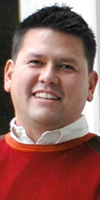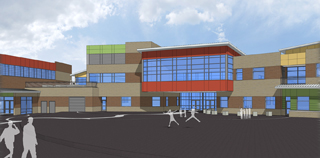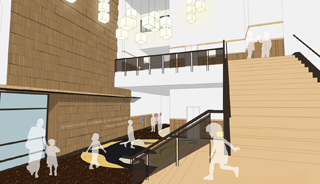|
Subscribe / Renew |
|
|
Contact Us |
|
| ► Subscribe to our Free Weekly Newsletter | |
| home | Welcome, sign in or click here to subscribe. | login |
Construction
| |
 |
August 25, 2011
Tacoma elementary turns to Montessori to attract students
Hutteball & Oremus Architecture

Murakami
|
It has never been more apparent that the world is changing, and the era of the traditional educational delivery model has long since passed.
Thinking back to our experiences in the traditional classroom, we were set upon a path towards a single career with a foundation built upon the memorization of discreet facts. It’s time for a change, and Tacoma Public Schools is leading the way. Putting a progressive foot forward, Tacoma is looking to break the mold of the traditional stand-and-deliver educational model with the construction of the new Geiger Montessori School.
In “Rethinking the Future,” futurist Alvin Toffler gives us insight to the critical skill set required of today’s learner.
He states, “The illiterate of the 21st century will not be those who cannot read and write, but those who cannot learn, unlearn and relearn.”
This ability to adapt and re-adapt is not fostered in the traditional learning environment. Steve Hughes, a pediatric neuropsychologist, suggests that one third of students work well and can thrive in the traditional setting, while another third are killing time, coasting through the system. Most troublesome are the last third, where the established method is actually destructive for the students, negatively impacting their development.
So, how do we engage the student? How do we personalize their educational experience? The answer may lie in project-based learning and the Montessori method.
Student-centered approach
Project-based learning is the basis of Montessori education, and is a model for classroom activity that shifts away from teacher-centered delivery to student-centered exploration. This instructional approach is built upon authentic learning that engages the student in relevant exercises at their pace, and from a multitude of vantage points.
At the heart of the program are hands-on learning kits, often referred to as “manipulatives.” Students work through these exercises at their own pace, with the teachers acting as guides.
With the mantra of “I do, we do, you do,” students first watch the guide work through the exercise, and then set out to work with the guide to solve the problem. Students continue on until they have mastered the exercise on their own.
This model of repetition is also revealed in the grouping of student grade levels into houses. Students work alongside each other in three grade-level “houses.”
In this configuration, you will find kindergartners, first graders and second graders in a shared classroom. Students have the opportunity to see and work with older and younger students, giving each the chance to be the student, the partner, or the “guide.”
Montessori is dedicated to keeping learning relevant and useful to students by establishing connections to life outside the four walls of the classroom, and solving real-world concerns with real-world skills. This approach offers wide scope development of the whole person, and reinforces the skill set required by the 21st-century learner: critical thinking, collaboration and communication.
Montessori magnet school
Building upon the successful conversion of Bryant Elementary to the Bryant Montessori School, Tacoma Public Schools looked to boost enrollment in the northwestern portion of its district by creating a new Montessori magnet school. Unlike Bryant, Geiger Montessori would be built from the ground up, specifically designed to house the Montessori program.
From the street, the new Geiger Montessori will look like a modern elementary school, but once inside, visitors will see manifestations of the Montessori approach integrated into the facility. A critical part of the Montessori method is a connection to people and place, peaceful interactions with others and the environment.
The design for Geiger started with the story of the site. As it descends from east to west, the site comes to rest with a territorial view over the Narrows and Puget Sound. With the orca as their mascot, the nearby marine environment is a constant reminder that their actions have an effect on the neighboring ecosystem.
Rainwater, like a stream, falls, twists and turns as it is channeled in surface runnels, distributed to outfalls and cisterns for irrigating. Signage is designed to remind students of the importance of water quality and the role they play in maintaining healthy waters.
Inside the facility, graphics derived from mathematical manipulatives drive the wainscot and railing patterns, and similar derivations are incorporated throughout as a tribute to the Montessori principals and lessons. Marine themes are used throughout the classroom wings to build individual identities for the six classroom pods, with each classroom having its own unique marine mascot.
The classrooms are zoned for various uses, and do not have a traditional front or back. The entry corners are developed into large wet areas for practical life exercises, often taking up to one-fourth of the classroom.
The rest of the floor area is divided into shelving areas to house the large library of manipulatives. Students define their space by placing a small rug on the floor and working from there. Most teachers do not have a desk in the room, and instead act as guides, often floating between student activities, giving encouragement wherever it is needed.
The well-rounded learning opportunities afforded by the Montessori approach have been traditionally confined to private schools. With the development of the new Geiger Montessori School, Tacoma Public Schools is taking this method to the masses, offering student-centered, personalized educational opportunities for public school students.
Stephen Murakami is an architect at Hutteball & Oremus Architecture. He has been designing educational facilities for the last 15 years, and is a past president of the Council for Educational Facility Planners International.
Other Stories:
- It’s time for Americans to rethink the classroom
- Designing schools for tomorrow’s scientists and engineers
- New schools are shelving the old library
- Historic schools: Restore or replace?
- Boom times at Boise State
- Induction systems can cut school HVAC costs
- How technology is reshaping the way students learn
- What I’ve learned after 15 years of designing schools




